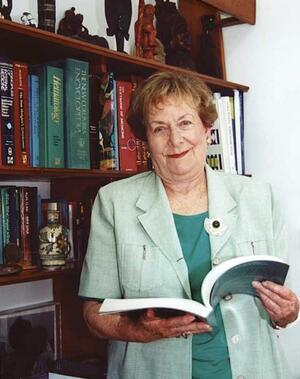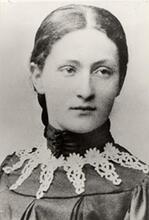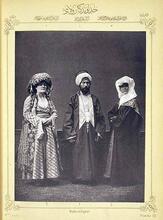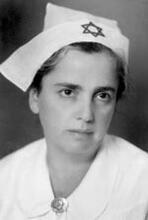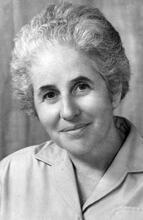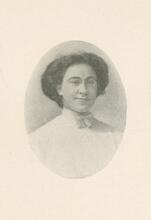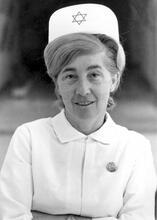Bracha Ramot
Photographer: Michal Roche-Ben Ami
Institution: Tel Aviv University
Bracha Ramot, born in 1927 in Lithuania, was a specialist in internal medicine and hematology. She made major contributions to the development of hematology in Israel and to research on the genetic differences of Jewish ethnic communities in Israel. As a hematologist, Ramot devoted much of her time and efforts to research on the environmental and genetical factors that influence hematological conditions, especially leukemias and lymphomas (malignant diseases of the lymphatic tissues). In the last twenty years of her work as a researcher Ramot dedicated most of her time and efforts to studying Hodgkin’s Disease type of lymphoma. Ramot, who overcame various obstacles and challenges in her personal life, was awarded the Israel Prize for Medical Sciences in 2001.
Bracha Ramot, a specialist in internal medicine and hematology, made major contributions to the development of hematology in Israel and to research on the genetic differences of Jewish ethnic communities in Israel. Ramot, who overcame various obstacles and challenges in her personal life, was awarded the Israel Prize for Medical Sciences in 2001.
Early Life and Education
Bracha Ramot was born on October 5, 1927, in Kovno, Lithuania, to Margalit (Finkelbrand, 1886–1981) and Motl-Berl Chweidan (1893–1957). She has one brother, Misha-Michael (b. 1929). Like most of the Jewish families in the small town of Raseiniai (Lithuania), where she grew up, her family was Zionist and the meeting place of Betar (the Revisionist youth movement) was in her parents’ home. Bracha Chweidan studied at a Hebrew elementary school. In 1941, a week before the war between Russia and Germany broke out, she and her family were exiled to the village of Syktyvkar (325 km north of Kirov). From 1941 to 1943 she attended high school at night. Since this small, remote village offered few educational opportunities, she registered for a course in disinfection. However, she was immediately offered admission into a nursing course and so pursued that instead. But after one year of studies she transferred to a feldsher track (a medical or surgical practitioner without full professional qualifications) and after graduating worked as a regional doctor in Syktyvkar.
After the war Ramot returned to Vilna and began to study medicine. In 1946 she left the USSR—a move which separated her from her family for twenty-eight years. Crossing the border to Poland, she joined the Ha-Shomer ha-Za’ir A voluntary collective community, mainly agricultural, in which there is no private wealth and which is responsible for all the needs of its members and their families.kibbutz in Łódź. She boarded the Theodor Herzl, intending to emigrate to Mandatory Palestine illegally, but the ship was intercepted en route by the British and Ramot was exiled to Cyprus together with the rest of the ship’s passengers.
In late 1947 Ramot was allowed to enter pre-state Israel and joined Kibbutz Lehavot ha-Bashan, where she worked as a nurse. During the War of Independence Ramot worked in the Safed Military Hospital and finally joined the Palmah’s Yiftah Brigade, which was stationed in the northern Negev. Chaim Sheba (1908–1971) and Baruch Padeh (b. 1908), who met Ramot during the war, encouraged her to study at the Faculty of Medicine that had opened at the Hebrew University of Jerusalem in May 1949. However, during her interview, one of the committee members tried to discourage her from studying medicine, arguing that the nation needed nurses more than physicians.
At the Hebrew University, she met fellow medical student Yehoshua Ramot (née Neuberger, 1925–1971), who later specialized in psychiatry and established the Psychological Services in the Israel Defense Forces. They married in 1949 and had a son, Arie, in 1957 and a daughter, Orna, in 1959. Bracha Ramot supported herself throughout her studies by working as a nurse.
In 1952, Ramot completed her medical studies with distinction and did her internship and first year of residency in internal medicine at Tel ha-Shomer Hospital, in Sheba’s department. Yehoshua Ramot wanted to specialize in psychiatry, which required study overseas. Following him to Chicago (1954–1956), she found a place where she could specialize in hematology and thus chose that field. She continued her studies at Albert Einstein College of Medicine in New York with Dr. Irving London (1956–1957), doing research on red blood cell metabolism.
Ramot’s Research
In 1957 Ramot returned to Tel ha-Shomer Hospital, established the Hematological Institute and served as its director from 1959 (at the age of 32) until 1991. At the end of the 1950s and early 1960s she started to focus on the genetics of Israel’s ethnic communities. Ramot studied G6PD deficiency, a genetic condition associated with hemolysis due to sulpha drugs and with a severe allergy to broad beans in some individuals. Because the gene for the Glucose–6-posphate dehydrogenase (G6PD) enzyme is located on the X chromosome, the trait is far more common in men than in women and it is also disproportionately represented in certain communities. Among the Jews of Kurdish descent, fifty-eight percent of the men suffer from G6PD deficiency, while some twenty-five percent of Jews of Iraqi descent suffer from this genetic defect.
Ramot also studied other hematological conditions such as Thalassemia, a genetic hemolytic anemia that is common mostly among peoples of the northern and eastern shores of the Mediterranean Sea, as well as among Jews from Kurdistan. Other genetically determined characteristics that were the focus of her research interests were the distribution of the different haptoglobulins and transferin types in human serum. Although Israel lagged behind overseas facilities in equipment and financial resources, it had the great advantage of an enormous, varied human pool resulting from massive immigration. In addition, many of the new Jewish immigrants, like the Arab population, were of non-European stock. In some cases, blood samples taken in Israel were sent by airfreight to the United States for the newest available tests.
As a hematologist, Ramot devoted much of her time and efforts to research on the environmental and genetical factors that influence hematological conditions, especially leukemias and lymphomas (malignant diseases of the lymphatic tissues). In the last twenty years of her work as a researcher Ramot dedicated most of her time and efforts to studying Hodgkin’s Disease type of lymphoma. She described a special clinical entity of lymphoma of the small bowel in Arab and Jewish young adults of North African ancestry. In this field, too, she enjoyed excellent collaborations with colleagues overseas.
Other Accomplishments
From 1961 Ramot taught at the Faculty of Medicine at the Hebrew University of Jerusalem and was among the founders of Tel Aviv University’s Faculty of Medicine, where she began teaching in 1966. Her students include many of the current heads of hematology departments in hospitals throughout Israel. Promoted to associate professor in 1966, Ramot attained the rank of full professor in 1971, and held many positions in Tel Aviv University’s academic framework.
Widowed in 1971, Ramot continued working while raising her two young children, aged eleven and thirteen. Her mother and brother immigrated in 1974. From 1973 to 1979 Ramot headed the Magen David Adom blood bank on a voluntary basis and from 1973 she was a member of the board of directors of the Israel Cancer Association. Ramot was nominated as the 1980–1981 Fogarty International Scholar of the U.S. National Institutes of Health (NIH). In 1991 she became the head of the health division of the medical branch of the Maccabi health fund. In this function she facilitated the cooperation between the various health funds in Israel. As with her other positions, Ramot remained at Maccabi for only five years, abiding by her principle that rotation in management is critical. In 1996 she became a member of the Committee on the Future of Public Medical Service and of the Health Services Basket Committee.
Bracha Ramot died on May 29, 2006.
Selected Works
Ramot, Bracha, P. Zikert-Duvdevani, and G. Tauman. “Distribution of Haptoglobin Types in Israel.” Nature 192 (1961): 765–766.
Ramot, Bracha, P. Duvdevani-Zikert, and G. Kende, “Haptoglobin and Transferin Types in Israel.” Annals of Human Genetics 25 (1962): 267–271.
Cleve, H., Bracha Ramot and A.G. Bearn. “Distribution of the Serum Group-Specific Components in Israel.” Nature 195 (1962): 86–87.
Szeinberg, Arieh, Avinoam Adam, Israel Ashkenazi, Bracha Ramot, and Chaim Sheba, “G6PD Deficiency.” In: Elisabeth Goldschmidt, ed. The Genetics of Migrant and Isolate Populations, 268–271. New York: The Williams & Wilkins Company, 1963.
Ramot, Bracha, ed. Red Cell Structure and Metabolism, (Proceedings of a Colloquium). Jerusalem: Academic Press, 1969.
Ramot, Bracha and A. Many. Recent Results in Cancer Research: Current Problems in the Epidemiology of Cancer & Lymphomas. (Symposium of the Gesellschaft zur Bekmfung krebskrankheiten orderhein), 193–199. Dusseldorf: Springer, Berlin, Heidelberg, 1971.
Ramot, Bracha, guest ed. Genetic Polymorphism and Disease in Man. (Sheba International Symposium). Israel Journal of Medical Sciences 9 (1973).
Ramot, Bracha, H.S. Kaplan, and S. Rosenberg. Etiology, Immunology, Pathology, Treatment, Vol. 3. New York: Academic Press, 1981.
Ramot, Bracha. “A Dual Mechanism of ERFC Blocking in Hodgkin’s disease: The Possible Role of Ferritin.” In Malignant Lymphomas, edited by S. Rosenberg and H.S. Kaplan. New York: Academic Press, 1982.
Ramot, Bracha, I. Ben-Bassat, A. Many, et al. “Clinical and Epidemiological Observations in ALL Subtypes at the Sheba Medical Center, Israel.” In Modern Trends in Human Leukemia, edited by R. Neth, R.C. Gallo, M.F. Greaves, M. Moore and K. Winkler. Berlin: Springer, 1983.
Magrath, Ian, Gregory T. O’Conor and Bracha Ramot, eds. Pathogenesis of Leukemias and Lymphomas, Environmental Influences. Progress in Cancer Research & Therapy, Vol. 27. New York: Raven, 1984.
Ramot, Bracha, I. Ben-Bassat and M. Modan. “Observations on lymphatic malignancies in Israel.” In Pathogenesis of Leukemias and Lymphomas, Environmental Influences. Progress in Cancer Research & Therapy, Vol. 27, edited by Ian Magrath, Gregory T. O’Conor and Bracha Ramot, 141–145. New York: Raven,1984.

